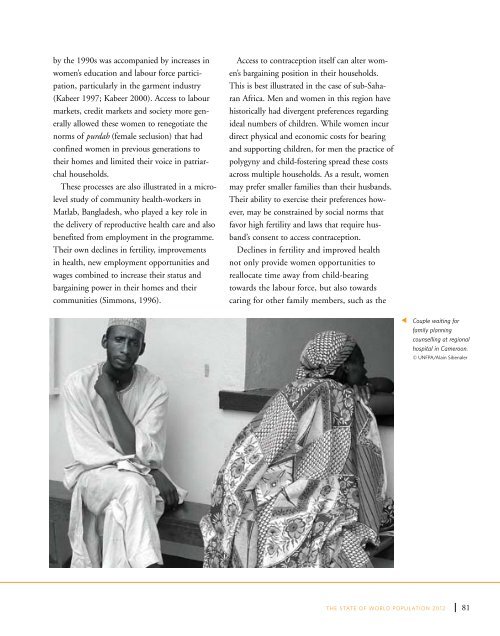State of World Population 2012 - Country Page List - UNFPA
State of World Population 2012 - Country Page List - UNFPA
State of World Population 2012 - Country Page List - UNFPA
Create successful ePaper yourself
Turn your PDF publications into a flip-book with our unique Google optimized e-Paper software.
y the 1990s was accompanied by increases in<br />
women’s education and labour force participation,<br />
particularly in the garment industry<br />
(Kabeer 1997; Kabeer 2000). Access to labour<br />
markets, credit markets and society more generally<br />
allowed these women to renegotiate the<br />
norms <strong>of</strong> purdah (female seclusion) that had<br />
confined women in previous generations to<br />
their homes and limited their voice in patriarchal<br />
households.<br />
These processes are also illustrated in a microlevel<br />
study <strong>of</strong> community health-workers in<br />
Matlab, Bangladesh, who played a key role in<br />
the delivery <strong>of</strong> reproductive health care and also<br />
benefited from employment in the programme.<br />
Their own declines in fertility, improvements<br />
in health, new employment opportunities and<br />
wages combined to increase their status and<br />
bargaining power in their homes and their<br />
communities (Simmons, 1996).<br />
Access to contraception itself can alter women’s<br />
bargaining position in their households.<br />
This is best illustrated in the case <strong>of</strong> sub-Saharan<br />
Africa. Men and women in this region have<br />
historically had divergent preferences regarding<br />
ideal numbers <strong>of</strong> children. While women incur<br />
direct physical and economic costs for bearing<br />
and supporting children, for men the practice <strong>of</strong><br />
polygyny and child-fostering spread these costs<br />
across multiple households. As a result, women<br />
may prefer smaller families than their husbands.<br />
Their ability to exercise their preferences however,<br />
may be constrained by social norms that<br />
favor high fertility and laws that require husband’s<br />
consent to access contraception.<br />
Declines in fertility and improved health<br />
not only provide women opportunities to<br />
reallocate time away from child-bearing<br />
towards the labour force, but also towards<br />
caring for other family members, such as the<br />
t<br />
Couple waiting for<br />
family planning<br />
counselling at regional<br />
hospital in Cameroon.<br />
© <strong>UNFPA</strong>/Alain Sibenaler<br />
THE STATE OF WORLD POPULATION <strong>2012</strong><br />
81
















